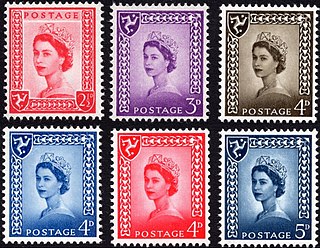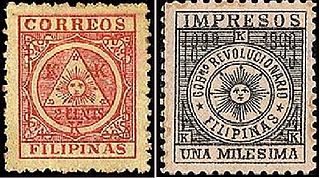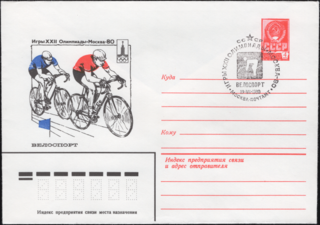
A postage stamp is a small piece of paper issued by a post office, postal administration, or other authorized vendors to customers who pay postage. Then the stamp is affixed to the face or address-side of any item of mail—an envelope or other postal cover —which they wish to send. The item is then processed by the postal system, where a postmark or cancellation mark—in modern usage indicating date and point of origin of mailing—is applied to the stamp and its left and right sides to prevent its reuse. Next the item is delivered to its addressee.

Keirin – literally "racing cycle" – is a form of motor-paced cycle racing in which track cyclists sprint for victory following a speed-controlled start behind a motorized or non-motorized pacer. It was developed in Japan around 1948 for gambling purposes and became an official event at the 2000 Olympics in Sydney, Australia.

A velodrome is an arena for track cycling. Modern velodromes feature steeply banked oval tracks, consisting of two 180-degree circular bends connected by two straights. The straights transition to the circular turn through a moderate easement curve.
This is a list of philatelic topics.
Cycle sport is competitive physical activity using bicycles. There are several categories of bicycle racing including road bicycle racing, cyclo-cross, mountain bike racing, track cycling, BMX, and cycle speedway. Non-racing cycling sports include artistic cycling, cycle polo, freestyle BMX, mountain bike trials, hardcourt bike polo and cycleball. The Union Cycliste Internationale (UCI) is the world governing body for cycling and international competitive cycling events. The International Human Powered Vehicle Association is the governing body for human-powered vehicles that imposes far fewer restrictions on their design than does the UCI. The UltraMarathon Cycling Association is the governing body for many ultra-distance cycling races.
The National Cyclists' Union (NCU) was an association established in the Guildhall Tavern, London, on 16 February 1878 as the Bicycle Union. Its purpose was to defend cyclists and to organise and regulate bicycle racing in Great Britain. It merged with the Tricycle Association in 1882 and was renamed the National Cyclists' Union in 1883.

Scottish Cycling, legally the Scottish Cyclists' Union (SCU), is the governing body for cycle sport in Scotland and is part of British Cycling, the national governing body in Britain.
Ascension Island is an island in the South Atlantic Ocean, part of the wider British overseas territory of Saint Helena, Ascension and Tristan da Cunha. Like other British Overseas Territories, it issues its own postage stamps, which provide a source of income for the island from sales to overseas collectors, as well as being used for domestic and international postage.

The Herne Hill Velodrome is an outdoor velodrome in Herne Hill, in south London. It is one of the oldest cycling tracks in the world, having been built in 1891. It hosted the track cycling events in the 1948 Summer Olympics and was briefly the home of Crystal Palace Football Club during World War I.

This is a survey of the postage stamps and postal history of Cuba.

The postal history of Malta began in the early modern period, when pre-adhesive mail was delivered to foreign destinations by privately owned ships for a fee. The earliest known letter from Malta, sent during the rule of the Order of St John, is dated 1532. The first formal postal service on the islands was established by the Order in 1708, with the post office being located at the Casa del Commun Tesoro in Valletta. The first postal markings on mail appeared later on in the 18th century.

U.S. Special Delivery was a postal service paid for with additional postage for urgent letters and postal packets which are delivered in less time than by standard or first class mail service. Its meaning is different and separate from express mail delivery service. Essentially it meant that a postal packet was delivered from a post office to the addressee immediately once it arrived at the post office responsible for delivering it, rather than waiting for the next regular delivery to the addressee.

The Palestinian National Authority began in 1994 to issue stamps and operate postal services as authorized by the Oslo Accords.

The postal history of Turkey and its predecessor state, the Ottoman Empire, dates to the 18th century when foreign countries maintained courier services through their consular offices in the Empire. Although delayed in the development of its own postal service, in 1863 the Ottoman Empire became the second independent country in Asia to issue adhesive postage stamps, and in 1875, it became a founding member of the General Postal Union, soon to become the Universal Postal Union. The Ottoman Empire became the Republic of Turkey in 1923, and in the following years, its postal service became more modernized and efficient and its postage stamps expertly designed and manufactured.

The Tuvan People's Republic issued postage stamps between 1926 and 1936. They were popular with stamp collectors in the Western world in the mid-twentieth century because of the obscurity and exoticism of Tannu Tuva and the stamps' quirky, colorful designs. The validity of many stamps purportedly issued by Tannu Tuva has been questioned by philatelists.

The postal history of the Pitcairn Islands began with letters being sent without postage stamps, as none were available on Pitcairn. In 1921, the United Kingdom and New Zealand formally agreed upon a system to handle post from the island, but this arrangement was ended in 1926. In 1927, stamps from New Zealand were introduced. To improve the revenue generation of the colony, the British government established an official post office on the island in 1940. The opening of this post office saw the issuance of the first set of Pitcairn Islands stamps.

The story of Japan's postal system with its postage stamps and related postal history goes back centuries. The country's first modern postal service got started in 1871, with mail professionally travelling between Kyoto and Tokyo as well as the latter city and Osaka. This took place in the midst of the rapid industrialization and social reorganization that the Meiji period symbolized in Japanese history. Given how the nation's railroad technology was in its infancy, Japan's growing postal system relied heavily on human-powered transport, including rickshaws, as well as horse-drawn methods of delivery. For example, while commemorating the 50th anniversary of Japan's postal service, the country's 1921 government released decorative postcards depicting intrepid horseback riders carrying the mail. This however was done to compare postal transport in past and present, as the other card showed modern transportation viz. rail and shipping. The railroad net from the north to the south, Aomori to Nagasaki, was completed in 1889. Prior to 1920s, local delivery was mainly by men- and horsepower, not principally different to Europe.

This is a survey of the postage stamps and postal history of the Isle of Man.

This is a survey of the postage stamps and postal history of the Philippines.

Bicycles on postal items includes bicycles on postal stationery and other postal items depicting bicycles such as postcards, first day covers and items delivered by bicycle mail. The collection of bicycles on postal items is commonly associated with collecting bicycles on stamps, or collecting the stamps and postal stationery of a specific country..



























